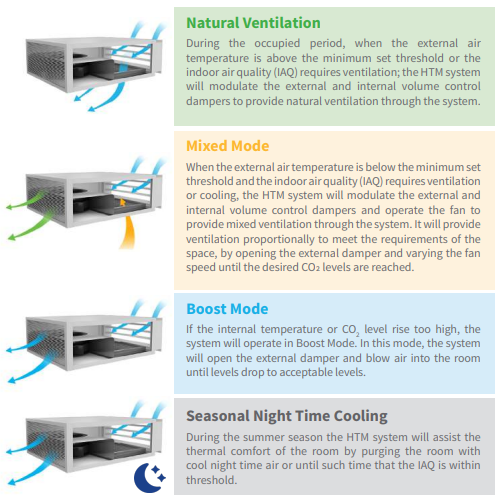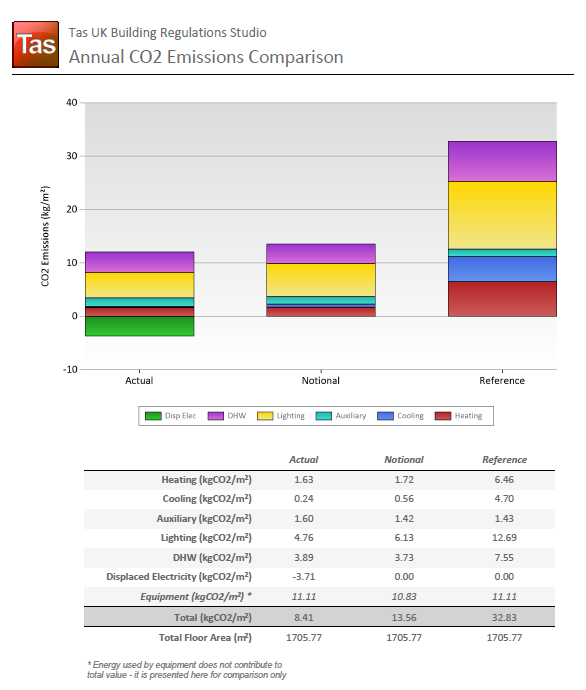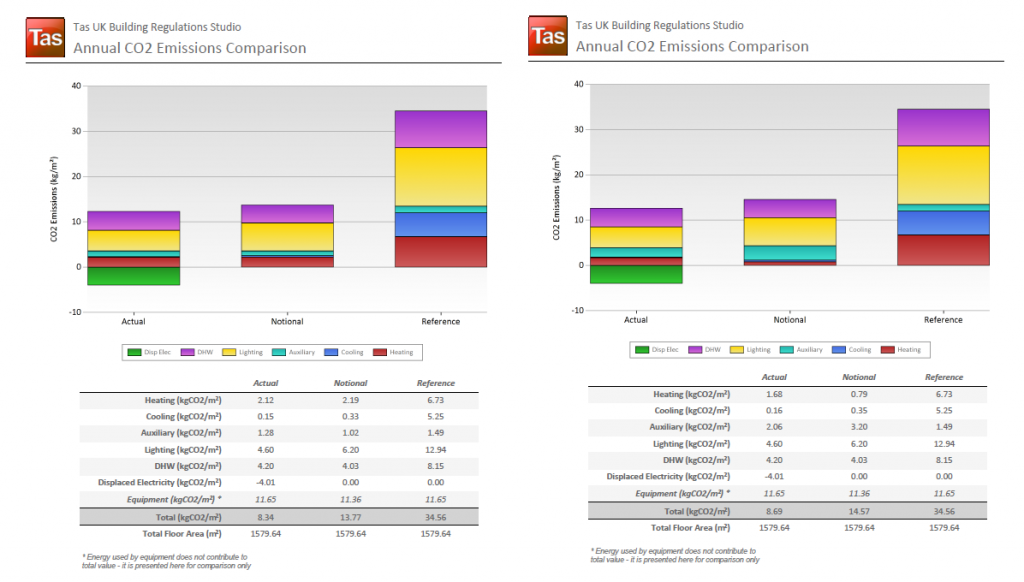Modelling hybrid ventilation units for part L2 and EPC purposes
Hybrid ventilation units have become very popular in recent years, often being used in priority schools as a lower energy alternative to mechanical ventilation or air conditioning. The units are available from a variety of manufacturers and often have a range of different ‘ventilation modes’ depending on the current internal and external conditions, they’re sometimes installed to help pass the BB101 assessment.
They are usually used in conjunction with openable windows and allow for air to naturally flow through the space when this will result in a comfortable environment for the occupants. When natural ventilation would result in an uncomfortable environment, either by high internal temperatures being reached or cold draughts near the windows the hybrid ventilation units change to a mechanically assisted mode.
A mechanically assisted mode can help alleviate high temperatures or CO₂ levels by providing a boost to the natural ventilation rate via running an integrated fan, meaning more fresh air is pulled into the space. Alternatively if the external temperature is very low the units often have an air mixing mode in which fresh air is mixed with air from the occupied space before being supplied, this means that the space can be provided with fresh air without the risk of occupants experiencing cold draughts.
Many of the units also utilise a ‘night mode’ in which the unit provides mechanical ventilation to reduce the temperature in the occupied space overnight. This can make use of the thermal mass within in the space while the outside air is cooler but it’s not possible to open the windows.

Image from Monodraught’s hybrid ventilation brochure showing some of the different modes of operation for their units
As the fans work in conjunction with natural ventilation and are not needed at all times these units often boast low Specific Fan Powers (SFPs) and can save on energy consumption in the building when compared to a full mechanical ventilation system. The difficulty with modelling these units for Part L2 and EPC assessments however comes from the regulations assessment methodology.
The L2 and EPC assessments are a comparisons against similar ‘notional’ and ‘reference’ buildings, these buildings will have the same building envelope size and location but will use set HVAC efficiencies. To make this possible the regulations outline that a HVAC system type for each space in the building must be selected from a list of pre-set options, for these units there are two possible options, naturally ventilated and mechanically ventilated. There is currently no option to model the hybrid units as they perform in reality for this assessment.

CO₂ emissions comparison for an actual, notional and reference building produced by Tas.
Modelling the spaces served by these units as naturally ventilated results in all fresh air requirements in your ‘actual’ building and the ‘notional’ building spaces to be provided naturally, thus no fans are included in the assessment and the benefit of the low SFPs achieved are not accounted for.
Unfortunately choosing to model the spaces as mechanically ventilated is also not ideal as this will result in having all air provided to the spaces in both the ‘actual’ and ‘notional’ building be supplied mechanically. As the units are not designed to work in this manner it is unclear if the low SFPs would still be applicable, additionally the units will be compared against mechanical ventilation heat recovery (MVHR) units which will be sized to provide all of the required fresh air mechanically and so are likely to have higher SFPs. This is an unfair comparison as the hybrid units do not necessarily have to be sized to provide the whole fresh air requirement to the spaces they serve. The heat recovery adds additional complexity as many of the hybrid units do not have mechanical heat recovery and so in some cases being compared against a space with MVHR units can have a negative impact on the results due to higher heating loads vs the ‘notional’ building.

Two CO₂ emissions comparisons for the same priority school building with hybrid units, the one on the left has the spaces served by the units modelled as naturally ventilated and the one on the right has them modelled as mechanically ventilated.
So how are you meant to model hybrid ventilation units for the purpose of L2 and EPC assessments if neither option is ideal? We asked CIBSE for clarification on the matter as they’re the governing body for all EPCs lodged in-house at EDSL and their response was as follows:
“We had this question a few times in the past, for project that are mostly schools where these appear to be popular.
We don’t have a definitive answer to this, we appreciate the arguments on both sides and the two different approaches.
The NCM modelling guide in paragraph 46 states that if a mechanical ventilation system only works on peak conditions and it otherwise it generally is natural ventilation, then the space should be considered naturally ventilated and any mechanical ventilation aspects ignored. This is the approach that the people who opt for the natural ventilation option would follow.
On the other hand, there is no clear line of what would be considered only working at peak conditions etc., the line is not clearly drawn, and because the system does indeed include a fan, a lot of assessor would consider this a mechanical ventilation system with a very low SFP.
We have advised in the past that we tend to lean towards the guidance in the NCM modelling guide, but generally advised assessors to liaise with Building Control to agree an acceptable approach.
I hope this helps a bit, I am afraid there is no clear cut right/wrong answer, these system appear to be too complicated for the NCM as it is structured today.”
So to summarise there isn’t a clear cut answer as not all applications of hybrid units are the same. If the majority of the ventilation to the space throughout the year is via natural ventilation and the mechanically assisted modes kick in during peak conditions (high CO₂ or temperatures) then we would suggest these should be modelled as naturally ventilated spaces for the purpose of Part L2 and EPC assessments. However if the majority of the ventilation throughout the year is provided by a fan assisted mode there is no clear option and it is advised to liaise the Building Control Officer (BCO) for the building.
The problem with modelling these hybrid ventilation units doesn’t come from limitations within the software package but with the current methodology set out by the regulations, perhaps in the future the methodology will be updated and there will be a clearer cut method for modelling these units in L2 and EPC assessments.
If you have an L2 or EPC assessment either involving or not involving hybrid ventilation units you would like assistance with, feel free to contact our consultancy department.
We also have a guide on how to model Breathing Buildings NVHR units if you would like more in depth information on this.
